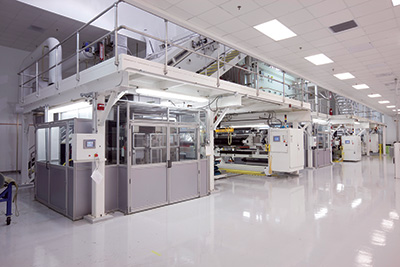Value-Added Processes: Coating, Laminating and Metallizing
- Published: June 07, 2021
By Lee Ostness, Product Manager – Coating & Drying at Davis-Standard
 Coating, laminating and metallizing are value-added processes that enhance a base web into a higher-value end product. In some converting processes, all three operations (coating, laminating and metallizing) occur for applications such as window film and paint protection films. These innovative treatments are improving the inherent characteristics of many products that impact daily living within the food packaging, automotive, construction and healthcare segments.
Coating, laminating and metallizing are value-added processes that enhance a base web into a higher-value end product. In some converting processes, all three operations (coating, laminating and metallizing) occur for applications such as window film and paint protection films. These innovative treatments are improving the inherent characteristics of many products that impact daily living within the food packaging, automotive, construction and healthcare segments.
Davis-Standard addresses these processes through customer consultation, machinery design, performance engineering, installation and start-up expertise. The company’s legacy equipment brands support both extrusion and converting applications, diverse substrates, and end-use products for nearly every market. Specific to coating and laminating, Davis-Standard is known for automatic profile control (APC), deckle and die technology, multi-coating solutions, web handling, transfer unwinds and winders. The company is also at the forefront of digital transformation for smarter manufacturing. Davis-Standard recently introduced the DS Activ-Check™ which uses the interconnectivity of the Industrial Internet of Things (IIoT) to turn machine data into meaningful production gains. Extensive capabilities and a trusted network of suppliers enables Davis-Standard to offer single-source responsibility and robust aftermarket services to customers worldwide. This includes laboratory testing and evaluation at R&D facilities in the United States and Europe.
Davis-Standard’s solution coating and extrusion coating machinery is focused on efficiency, quality and value. Solution coating machinery supports a range of opportunities from simple priming, to adhesive applications, to solar receptive coatings. The solution can be water-based, solvent-based, or 100 percent solids. Extrusion coating machinery is built for versatility for adding different polymers to the primary web as a moisture barrier, vapor barrier, or has a strengthening agent. Davis-Standard’s coating platforms are known for handling the most demanding flexible packaging, non-woven, paper and board coating, and laminating applications and our team can with you to determine specific requirements and equipment needed to achieve desired results.
In terms of laminating or bonding two webs/substrates together, processors can use solution coating (adhesive), or a melt extrudate using extrusion lamination. Examples of end-use products that use solution coating include tape, roofing and solar films. Examples of end-use applications that use extrusion lamination include food packaging, juice boxes, battery layers, trash bags and agricultural films. Key design considerations when selecting a coater/laminator include:
- Substrate and overall structure
- Nature of coating and lamination structure
- Desired outputs
- Coater – coating thickness and uniformity plus drying rate
- Laminator – thickness of structures being laminated
- Desired adhesion levels
- Flexibility to change resins
- Ease of quick changes
- Evaluation of unwind and winder for the overall quality of the end roll
Davis-Standard’s engineering team works with customers to address specific lamination requirements, taking into consideration current and future business objectives.
Metallizing is used primarily for functional (barrier), decorative and aesthetic applications. This can be achieved by laminating a 0.0003” foil to a paper/film web by adding a solution-coated adhesive or by laminating the foil using an extrusion lamination process. Davis-Standard supports both of these processes. There is also vacuum metallizing and sputter metallizing, but these methods are not within Davis-Standard’s expertise. It’s important to note that when metallizing on paper, there is a special coating required to accept the metallization. Davis-Standard’s strength is in handling and using thin-gauge foil at high speeds to make this possible.







